Meta Prophet
Prophet is a procedure for forecasting time series data based on an additive model where non-linear trends are fit with yearly, weekly, and daily seasonality, plus holiday effects. It works best with time series that have strong seasonal effects and several seasons of historical data. Prophet is robust to missing data and shifts in the trend, and typically handles outliers well.It is designed to se automatically find a good set of hyperparameters for the model in an effort to make forrecast for time series with seasonality and trends.
The Prophet model is not autoregressive, like ARIMA, exponential smoothing, and the other methods we study in a typical time series course (including my own).
The 3 components are:
The trend g(t) which can be either linear or logistic.
The seasonality s(t), modeled using a Fourier series.
The holiday component h(t), which is essentially a one-hot vector “dotted” with a vector of weights, each representing the contribution from their respective holiday.
pip install prophetSpecial thanks to Zohoor Nezhad Halafi for contributing this notebook! Connect with her on LinkedIn.
[1]:
import pandas as pd
import numpy as np
import seaborn as sns
import matplotlib.pyplot as plt
from scalecast.Forecaster import Forecaster
sns.set(rc={'figure.figsize':(16,8)})
Loading time series
[2]:
data = pd.read_csv('daily-website-visitors.csv',parse_dates=['Date'])
[3]:
data=data[['First.Time.Visits','Date']]
[4]:
data.head()
[4]:
| First.Time.Visits | Date | |
|---|---|---|
| 0 | 1430 | 2014-09-14 |
| 1 | 2297 | 2014-09-15 |
| 2 | 2352 | 2014-09-16 |
| 3 | 2327 | 2014-09-17 |
| 4 | 2130 | 2014-09-18 |
EDA
[5]:
f=Forecaster(y=data['First.Time.Visits'],current_dates=data['Date'])
f.plot()
plt.title('Orig Series',size=16)
plt.show()
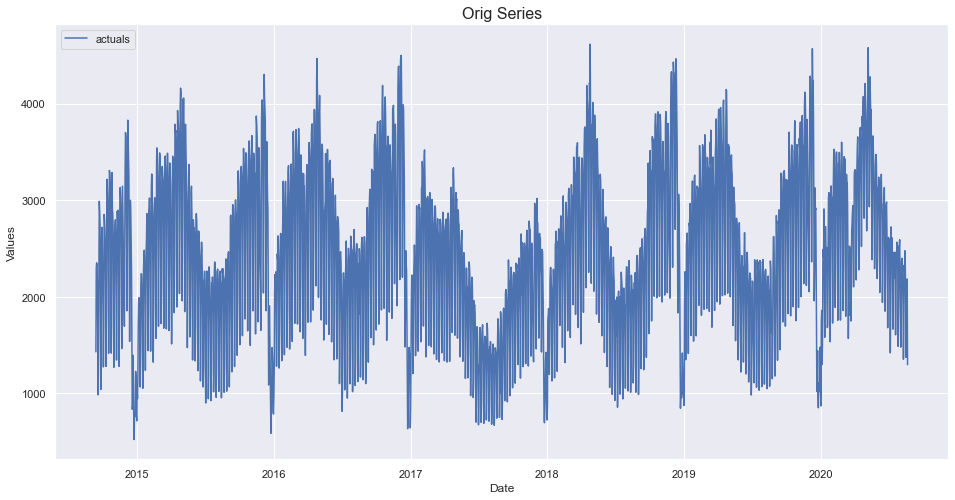
[7]:
figs, axs = plt.subplots(2, 1)
f.plot_acf(ax=axs[0],lags=120)
f.plot_pacf(ax=axs[1],lags=120)
plt.show()
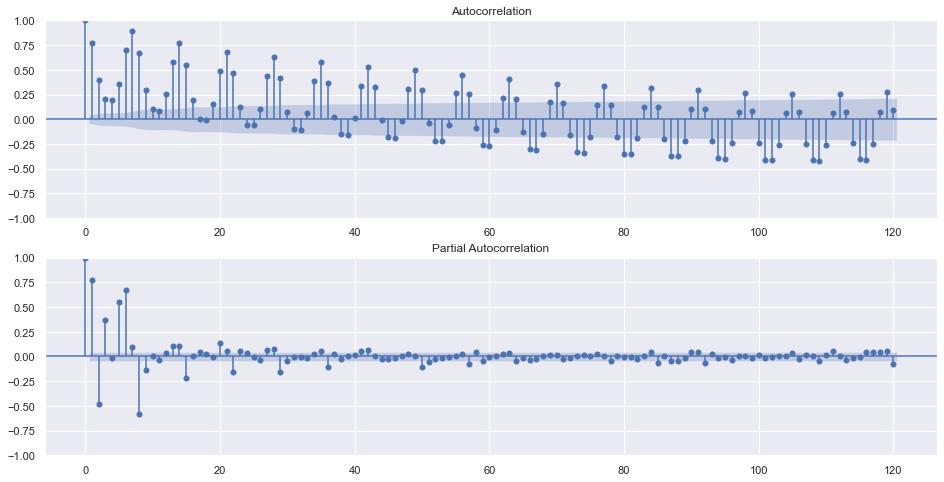
[8]:
f.seasonal_decompose().plot()
plt.show()
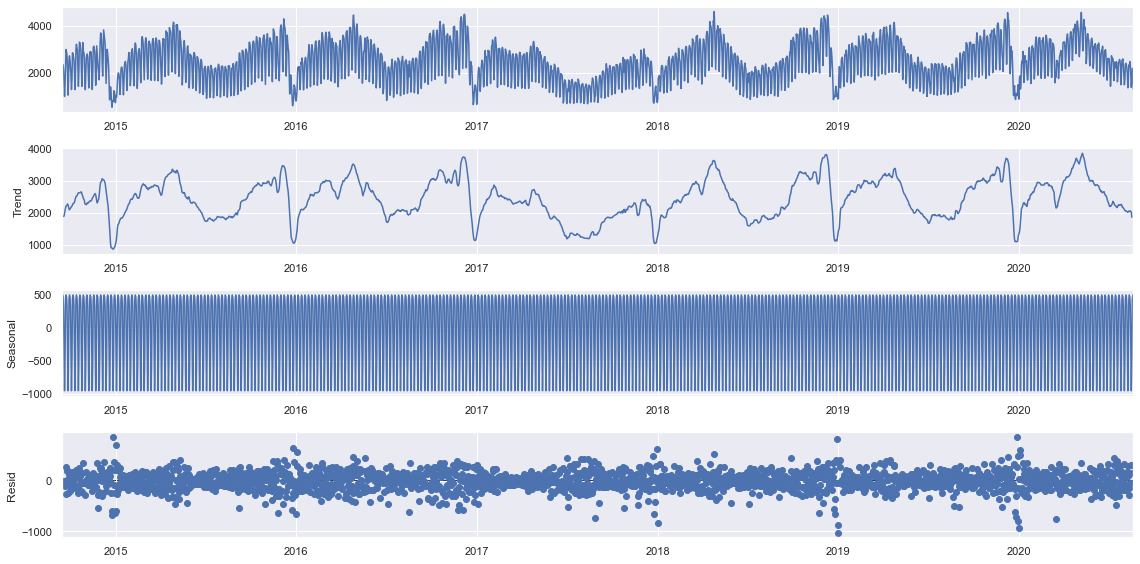
ADF Test
[9]:
critical_pval = 0.05
print('-'*100)
print('Augmented Dickey-Fuller results:')
stat, pval, _, _, _, _ = f.adf_test(full_res=True)
print('the test-stat value is: {:.2f}'.format(stat))
print('the p-value is {:.4f}'.format(pval))
print('the series is {}'.format('stationary' if pval < critical_pval else 'not stationary'))
print('-'*100)
----------------------------------------------------------------------------------------------------
Augmented Dickey-Fuller results:
the test-stat value is: -4.48
the p-value is 0.0002
the series is stationary
----------------------------------------------------------------------------------------------------
Preparing the data for modeling
[10]:
f.generate_future_dates(60)
f.set_test_length(.2)
f.set_estimator('prophet')
f
[10]:
Forecaster(
DateStartActuals=2014-09-14T00:00:00.000000000
DateEndActuals=2020-08-19T00:00:00.000000000
Freq=D
N_actuals=2167
ForecastLength=60
Xvars=[]
Differenced=0
TestLength=433
ValidationLength=1
ValidationMetric=rmse
ForecastsEvaluated=[]
CILevel=0.95
BootstrapSamples=100
CurrentEstimator=prophet
)
Forecasting
[11]:
f.manual_forecast(call_me='prophet1')
[12]:
f.plot_test_set(ci=True,models='prophet1')
plt.title('Default prophet Test Results',size=16)
plt.show()
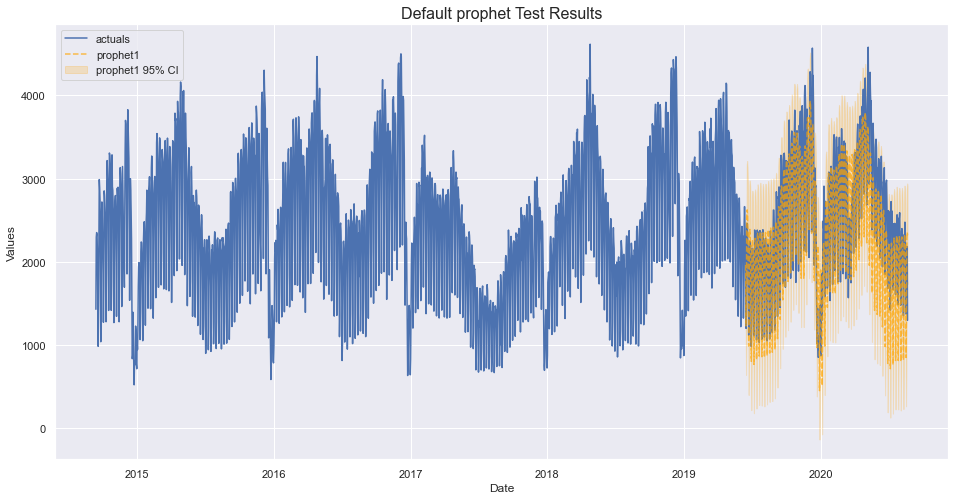
[15]:
results = f.export('model_summaries')
results[['TestSetRMSE','InSampleRMSE','TestSetMAPE','InSampleMAPE']]
[15]:
| TestSetRMSE | InSampleRMSE | TestSetMAPE | InSampleMAPE | |
|---|---|---|---|---|
| 0 | 403.968233 | 283.145403 | 0.136388 | 0.104243 |
[14]:
f.plot(ci=True,models='prophet1')
plt.title('Forecast results',size=16)
plt.show()
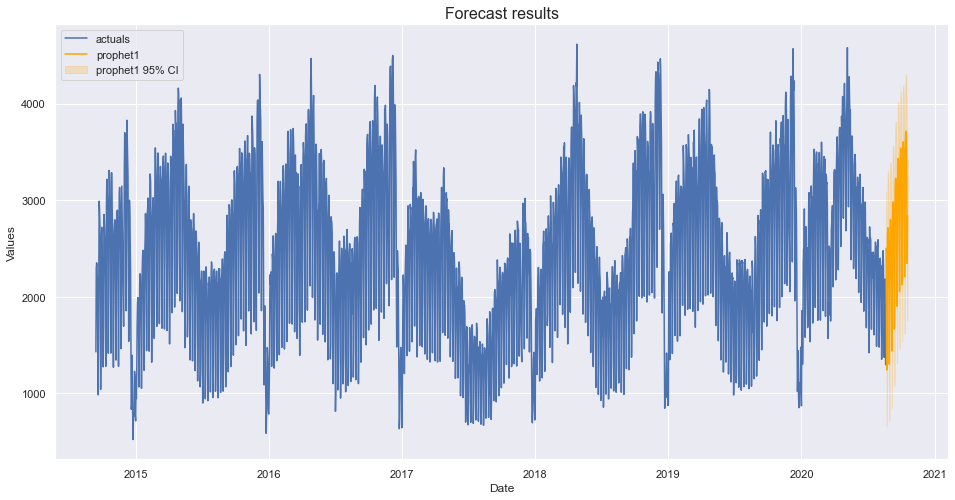
[ ]: